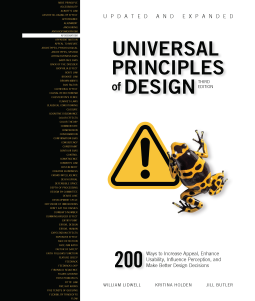
Universal Principles of Design, Updated and Expanded Third Edition
200 Ways to Increase Appeal, Enhance Usability, Influence Perception, and Make Better Design Decisions
by William Lidwell; Kritina Holden; Jill Butler
This title was previously available on NetGalley and is now archived.
Send NetGalley books directly to your Kindle or Kindle app
1
To read on a Kindle or Kindle app, please add kindle@netgalley.com as an approved email address to receive files in your Amazon account. Click here for step-by-step instructions.
2
Also find your Kindle email address within your Amazon account, and enter it here.
Pub Date 23 May 2023 | Archive Date 4 May 2023
Quarto Publishing Group – Rockport Publishing | Rockport Publishers
Talking about this book? Use #UniversalPrinciplesofDesignUpdatedandExpandedThirdEdition #NetGalley. More hashtag tips!
Description
Universal Principles of Design, Updated and Expanded Third Edition is a comprehensive, cross-disciplinary encyclopedia, now with fully updated existing entries and expanded with 75 new entries to present a total of 200 laws, guidelines, and considerations that are important to successful design.
Richly illustrated and easy to navigate, this essential design guide pairs clear explanations of every design concept with visual examples of the ideas applied in practice.
Whether a marketing campaign or a museum exhibit, a video game or a complex control system, the design we see is the culmination of many concepts and practices brought together from a variety of disciplines. Because no one can be an expert on everything, designers have always had to scramble to find the information and know-how required to make a design work—until now.
Each principle is presented in a two-page format. The left-hand page contains a succinct definition and a full description of the principle, examples of and guidelines for its use, and side notes that provide elaborations and references. The right-hand page contains visual examples and related graphics to support a deeper understanding of the principle.
The book is organized alphabetically so that principles can be easily and quickly referenced by name. From the Abbe Principle to the Zeigarnick Effect, every major design concept is defined and illustrated, including these new additions:
- Feature creep
- Gamification
- Root cause
- Social trap
- Supernormal stimulus
A landmark reference for designers, engineers, architects, and students, Universal Principles of Design has become the standard for anyone seeking to broaden and improve their design expertise, explore brainstorming ideas, and improve the quality of their design work.
The titles in the Rockport Universal series offer comprehensive and authoritative information and edifying and inspiring visual examples on multidisciplinary subjects for designers, architects, engineers, students, and anyone who is interested in expanding and enriching their design knowledge.
Available Editions
| EDITION | Other Format |
| ISBN | 9780760375167 |
| PRICE | US$40.00 (USD) |
| PAGES | 424 |
Available on NetGalley
Featured Reviews
I’m going to assume that the first thing you thought when you saw the cover of “Universal Principles of Design” by William Lidwell, Kritina Holden, and Jill Butler, was “Ah, they used a yellow-banded poison dart frog as an example of aposematism, how clever.” And if you thought that, you’re smarter than I am, because I was mystified by the cover until reaching Aposematism some 25 pages in. It still seems like an odd cover choice for a book on design.
You don’t have to be a designer to enjoy and learn from this book, I’m a writer but found each topic to be clearly defined, well illustrated and included fascinating examples. I thought a few of the examples seemed like the authors were stretching a cherished issue to fit a topic. For instance, using global warming as an example of a death spiral (meaning that the burning of fossil fuels will lead to the destruction of the human race) is alarmist and not backed up with a cited source.
The authors did a fine job of organizing the topics alphabetically and by category (engineers, architects, graphic designers, etc.), but I wish they’d also included the subheadings in at least one of the listings (for example, obscure topics like "Saint-Venant’s Principle” become infinitely clearer when the subheading "Local effects of loads on structures have negligible global effects” is added).
Highly recommended.






